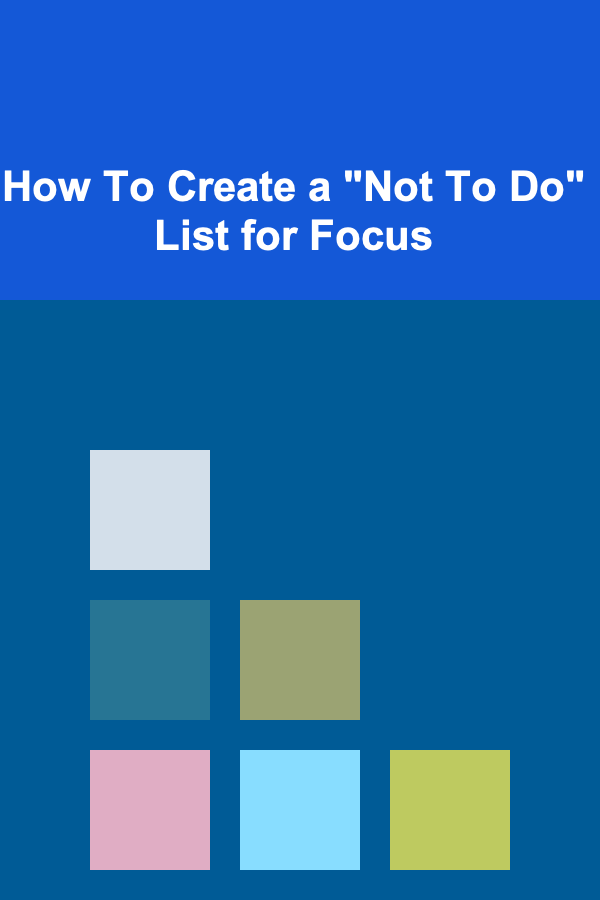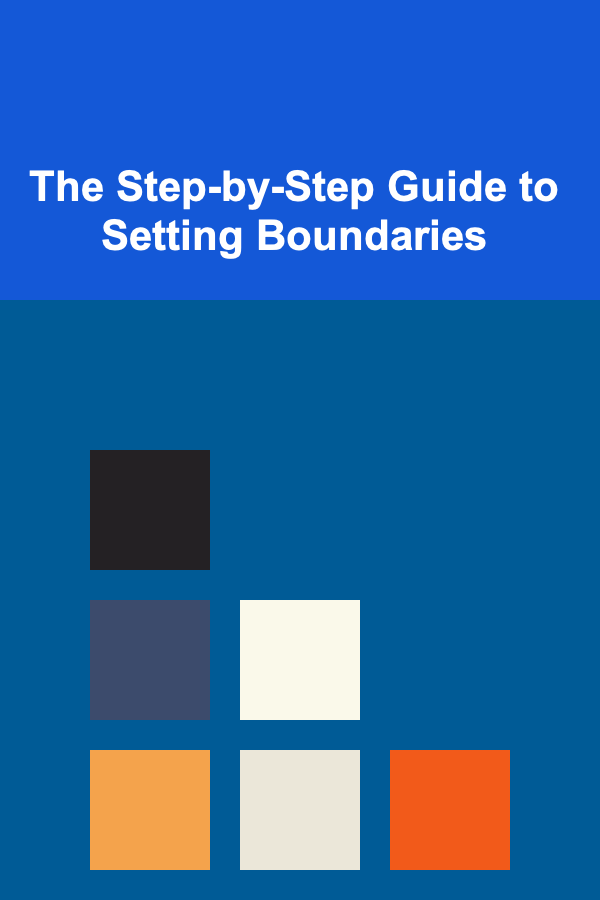
How To Create a "Not To Do" List for Focus
ebook include PDF & Audio bundle (Micro Guide)
$12.99$9.99
Limited Time Offer! Order within the next:

In today's world of constant distractions, staying focused can often feel like an impossible task. With smartphones buzzing, social media notifications flooding in, and endless tasks demanding attention, it's easy to find yourself bouncing between activities without ever completing anything. One powerful way to regain control over your time and attention is by creating a "Not To Do" list.
While we are all familiar with the concept of a to-do list, which helps us prioritize tasks, a "Not To Do" list focuses on identifying the habits, distractions, and unproductive activities that can undermine your focus. This approach is about setting boundaries, becoming more intentional about how you spend your time, and ultimately fostering a deeper sense of focus and productivity.
In this article, we will dive deep into how to create an effective "Not To Do" list and explore why eliminating the wrong things can be just as important as adding the right things to your routine. Let's begin by understanding the concept in more detail.
What Is a "Not To Do" List?
A "Not To Do" list is essentially a collection of habits, actions, behaviors, and distractions that you consciously choose to avoid in order to protect your time and maintain your focus. The idea is to acknowledge what doesn't contribute to your long-term goals or well-being and actively remove these items from your daily life. This strategy creates space for more meaningful work, healthier habits, and greater mental clarity.
Unlike a traditional to-do list, which is designed to help you accomplish specific tasks, a "Not To Do" list is focused on minimizing the things that hinder your productivity, drain your energy, or contribute to stress. By removing these things from your life, you can improve your ability to focus on what truly matters.
Why Is a "Not To Do" List Important for Focus?
1. Reduces Mental Clutter
In a world full of distractions, your mind is often overwhelmed by the sheer number of things you feel you should be doing. A "Not To Do" list helps reduce mental clutter by eliminating tasks that aren't aligned with your main objectives. This allows you to focus your energy on the activities that bring the most value.
2. Frees Up Time and Energy
By stopping yourself from engaging in unimportant or unproductive activities, you free up more time and mental energy to focus on the things that matter. This is especially critical in maintaining sustained attention on tasks that require deep work and concentration.
3. Improves Decision-Making
With a "Not To Do" list, you eliminate the need to make constant decisions about how to spend your time. When you have a clear understanding of what to avoid, you no longer waste mental energy debating whether a certain task is worth your attention.
4. Enhances Self-Discipline
Creating and sticking to a "Not To Do" list reinforces self-discipline. It requires you to confront and challenge habits and impulses that lead to distractions. Over time, this strengthens your ability to make better choices, especially in moments of temptation.
5. Boosts Mental and Physical Health
Distractions and multitasking can increase stress, reduce sleep quality, and hinder your ability to relax. A "Not To Do" list helps you protect your mental and physical health by encouraging you to avoid things that contribute to burnout, anxiety, and poor self-care habits.
Steps to Create an Effective "Not To Do" List
Now that we understand the importance of a "Not To Do" list, let's explore how to create one that effectively supports your focus and productivity.
1. Identify Your Key Distractions
The first step in creating a "Not To Do" list is to identify the things that regularly distract you from your goals. These distractions can be internal (like procrastination or negative self-talk) or external (like social media, email, or noisy environments).
Take some time to reflect on your daily routines and think about where your focus is often interrupted. For example:
- Do you find yourself constantly checking your phone, even when you need to focus on work?
- Are you frequently distracted by irrelevant emails or notifications?
- Do you tend to start multiple projects at once, only to abandon them before finishing?
Write down all of the distractions or habits that seem to steal your focus and make it harder to stay on track.
2. Analyze the Impact of Each Distraction
Once you've identified your key distractions, the next step is to analyze their impact on your focus. Some distractions may be minor but still annoying, while others may be significant time wasters or productivity killers.
Consider how each distraction affects your work or personal life. Does it prevent you from completing important tasks? Does it cause you stress or anxiety? By evaluating the impact of each distraction, you can prioritize which habits to eliminate first.
For example:
- Checking social media every 15 minutes might seem harmless at first, but it can add up to hours of lost time each week.
- Spending too much time on trivial meetings or phone calls might prevent you from engaging in deep, focused work.
- Procrastinating on difficult tasks may leave you feeling unproductive and frustrated at the end of the day.
3. Set Clear Boundaries
Once you've identified the distractions and evaluated their impact, the next step is to set clear boundaries around them. Boundaries are crucial in preventing distractions from creeping into your life.
For example:
- Set specific times during the day when you check your phone or social media, and avoid doing so outside of those times.
- Block out time in your calendar for uninterrupted work or personal time, and stick to it.
- Say no to meetings or tasks that aren't aligned with your main goals or priorities.
Establishing these boundaries helps you create a focused environment, whether you're working, studying, or relaxing. Having a structure in place will make it easier to avoid distractions.
4. Be Realistic and Flexible
Your "Not To Do" list should be realistic and adaptable. It's important not to overwhelm yourself with too many items or to set unattainable goals. Start by focusing on one or two major distractions, and gradually expand your list as you become more disciplined.
It's also important to be flexible. Life is unpredictable, and there may be times when a distraction is unavoidable. If you slip up or find yourself falling into old habits, don't be too hard on yourself. Simply refocus and get back on track. Over time, you'll develop a stronger sense of control over your habits.
5. Review and Adjust Your List Regularly
A "Not To Do" list is not a one-time task; it requires ongoing attention and adjustment. As your goals evolve and new distractions emerge, you may need to revisit and update your list. Regularly reviewing your list ensures that it stays relevant and that you're always focused on the right things.
Set aside time each week to assess your productivity and identify new distractions that might have crept into your routine. Adjust your boundaries and make changes as needed to stay on top of your focus.
Common Items to Include in a "Not To Do" List
To help get you started, here are some common items that many people include on their "Not To Do" lists:
- Checking email/social media constantly: Limit checking email and social media to specific times during the day.
- Multitasking: Focus on one task at a time, especially when working on deep or complex projects.
- Procrastinating on important tasks: Break tasks down into smaller, more manageable steps to reduce procrastination.
- Attending unproductive meetings: Politely decline meetings that are not essential to your work or goals.
- Spending time on low-value activities: Avoid activities that don't contribute to your personal growth, such as excessive TV watching or aimlessly scrolling online.
- Overcommitting to others: Learn to say no to requests that don't align with your priorities or long-term goals.
Conclusion
Creating a "Not To Do" list is a powerful tool for improving focus and productivity. By identifying the distractions and habits that take away from your ability to concentrate, you can actively choose to avoid them. This will help you prioritize your time, reduce mental clutter, and create space for the things that truly matter.
A "Not To Do" list is not a one-time exercise but an ongoing process of self-awareness, discipline, and adjustment. By continuously refining and reviewing your list, you can cultivate better focus, enhance your productivity, and achieve your long-term goals more effectively.

How to Cut Unnecessary Expenses Without Sacrificing Quality of Life
Read More
How to Organize Holiday Clothing for Easy Access
Read More
How to Secure Your Home When You Live Alone
Read More
Understanding Business Ethics for Small Businesses
Read More
The Step-by-Step Guide to Setting Boundaries
Read More
How to Optimize Your Engineering Portfolio for Job Applications
Read MoreOther Products

How to Cut Unnecessary Expenses Without Sacrificing Quality of Life
Read More
How to Organize Holiday Clothing for Easy Access
Read More
How to Secure Your Home When You Live Alone
Read More
Understanding Business Ethics for Small Businesses
Read More
The Step-by-Step Guide to Setting Boundaries
Read More